Papers by Pascale Salameh
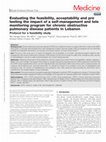
Case Medical Research, 2019
Background: Chronic obstructive pulmonary disease (COPD) has a significant impact on quality of l... more Background: Chronic obstructive pulmonary disease (COPD) has a significant impact on quality of life and is costly to the health care system. It has been demonstrated that a self-management program improves quality of life, but programs are not universally available and telehealth interventions can provide home-based support, but have mixed results. Aim: The aims of this study are to (1) assess the feasibility and acceptability of a 6 weeks' educational program related to selfmanagement with remote monitoring for Lebanese COPD patients; (2) pre-test its impact on quality of life, emergency visits, and rate of rehospitalization, and (3) to make recommendations for a future randomized trial. Methods: Validated questionnaires will be adapted to meet the context of our study in terms of acceptability, adoption, adequacy, fidelity, cost, and coverage. The impact of this program on quality of life will be measured with the COPD assessment test (CAT) and the COPD clinical questionnaire (CCQ), and the Hospital Anxiety and Depression (HAD) scale will be used to measure anxiety. All measures will be delivered pre-and post-intervention. To evaluate the impact of our program on the rate of hospitalization and emergency visits, the number of hospitalizations and emergency room visits during the year preceding the intervention will be collected from the hospital register of each participant. Discussion: This study is the first to evaluate the application of telehealth to optimize COPD management in Lebanon. The results of this study will provide evidence regarding the efficacy and feasibility of this approach for Lebanese patients with moderate to severe COPD. Abbreviations: CAT = COPD assessment test, CCQ = COPD clinical questionnaire, COPD = chronic obstructive pulmonary disease, ETP = therapeutic education program, GBD = global burden of disease, GOLD = global initiative for chronic obstructive lung disease, HAD = hospital anxiety and depression, HAS = high authority of health in France, HDF

Patient preference and adherence, 2017
Health warnings on tobacco packages have been considered an essential pillar in filling the gap o... more Health warnings on tobacco packages have been considered an essential pillar in filling the gap of knowledge and communicating the health risks of tobacco use to consumers. Our primary objective was to report the perception of smokers on the textual health warnings already appearing on tobacco packages in Lebanon versus shocking pictures about the health-related smoking consequences and to evaluate their impact on smoking behaviors and motivation. A pilot cross-sectional study was undertaken between 2013 and 2015 in five hospitals in Lebanon. Participants answered a questionnaire inquiring about sociodemographic characteristics, chronic respiratory symptoms, smoking behavior and motivation to quit smoking. Only-text warning versus shocking pictures was shown to the smokers during the interview. Exactly 66% of the participants reported that they thought shocking pictorial warnings would hypothetically be more effective tools to reduce/quit tobacco consumption compared to only textual...

Geriatric Mental Health Care, 2013
ABSTRACT Introduction: The percentage of dement edelderly is increasing worldwide and in Lebanon.... more ABSTRACT Introduction: The percentage of dement edelderly is increasing worldwide and in Lebanon. Improvement in nutritional status would improve cognition in elderly.The purpose of this work is to investigate the presence of an association between nutritional status and cognitive function in elderly living in Lebanese institutions. Materials and methods: This isacross- sectional study performed in three long-stay elderly institutions in Beirut. Subjects who met the inclusion criteria filled out a questionnaire consisting of nutritional status scale (Mini Nutritional Assessment: MNA), cognitive function (Mini Mental State Evaluation: MMSE) and other parts (demographic, self-assessment of the state health, smoking and alcohol, physical dependence, quality of life, frailty, depression, social isolation and loneliness). Results: Among 111elderly (55 men and 56 women),14(12.6%) elderly are malnourished, 54(48.7%) are at risk of malnutrition and 43(38.7%) had adequate nutrition. The majority of malnourished elderly (71.43%) showed a cognitive function deterioration (MMSEo24). The MMSE mean scores of malnourished elderly (20.21±4.61) was significantly lower (P=0.008) than elderly at risk of malnutrition and elderly with normal nutritional status (respectively 22.61±4.25 and 24.37±3.63). There was a significant positive correlation between the MMSE score and the MNA score (r=0.208, P=0.028). Multivariate analysis showed that cognitive state of elderly was only explained by lower nutrition status (ORa=3.03) and education (ORa=1.72). Conclusion: Nutritional status is associated with cognitive function. Monitoring the status of elderly can help in preventing malnutrition and possibly their cognitive impairment.

Abstract: Objectives: This study aimed to assess the nutritional status, measured by MNA, and its... more Abstract: Objectives: This study aimed to assess the nutritional status, measured by MNA, and its association with socio-demographic indicators and health related characteristics of a representative sample of community dwelling elderly subjects. Design: Cross-sectional study. Setting: Community dwelling elderly individuals living in rural communities in Lebanon. Participants: 1200 elderly individuals aged 65 years or more. Measurements: Socio-demographic indicators and health related characteristics were recorded during a standardized interview. Nutritional status was assessed through Mini Nutritional Assessment (MNA). The 5-item GDS score and the WHO-5-A score were used to assess mood, whereas Mini Mental Status (MMS) was applied to evaluate cognitive status. Results: The prevalence of malnutrition and risk of malnutrition was 8.0% respective 29.1% of the study sample. Malnutrition was significantly more frequent in elderly subjects aged more than 85 years, in females, widowed and ...

Journal of Hypertension, 2015
Objective: The aim of our study was to create a medication adherence score for chronic diseases, ... more Objective: The aim of our study was to create a medication adherence score for chronic diseases, and to evaluate the influence of different socio-demographic and medical or clinical factors on the level of adherence. Design and method: We conducted an observational cross-sectional survey in a Lebanese sample population. Participants were chosen randomly from different pharmacies. Lebanese adults with chronic diseases on daily per os medications since at least six months were eligible to participate. Participants filled a questionnaire about socio-demographic and medical information with 16 questions about medication adherence. Results: 545 patients were interviewed. The mean age of the participants was 58.8 ± 13.5 years. More than half (52.1%) of the participants were males. Factor analysis, with principle component extraction method and varimax rotation, of the 16 questions leads to a medication adherence score of 15 questions constituted of 4 factors: psychological, occupational, ...
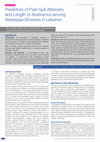
JOURNAL OF CLINICAL AND DIAGNOSTIC RESEARCH, 2018
Introduction: The popularity of waterpipe smoking is dramatically increasing in Lebanon, reaching... more Introduction: The popularity of waterpipe smoking is dramatically increasing in Lebanon, reaching 36.9%, the highest among countries in the region, with a false belief that waterpipe is less dangerous and toxic compared to cigarettes. Aim: To assess factors associated with the quit attempts and their past length of abstinence in a Lebanese sample of waterpipe smokers. Materials and Methods: A cross-sectional study was conducted between March 2014 and March 2015 involving 127 patients. A questionnaire was completed by each participant; Quit attempts, real quit attempt durations and the intention to seriously quit waterpipe smoking in 2 months were assessed. Two forward logistic regressions were performed, taking into account the variables in the bivariate analysis that showed a p-value <0.2. Results: Past attempt to quit waterpipe smoking was significantly higher among smokers who had cough and expectoration for more than 3 weeks (OR=8.2), at higher stages of readiness to quit (OR=2.78) and being highly motivated (OR=2.27). A longer duration of abstinence to smoke waterpipe was higher among waterpipe smokers less than 45 years (OR=6.85), who considered it very important to report health warning on tumbac packages (OR=3.09) and with a low waterpipe dependence (OR=2.13). Conclusion: Health care professionals should play an important role in explaining the side effects of waterpipe smoking in order to decrease dependence.

BMC Pediatrics, 2020
Background This study objective was to evaluate the prevalence of alcohol use disorder (AUD) and ... more Background This study objective was to evaluate the prevalence of alcohol use disorder (AUD) and related factors (smoking, internet addiction, social anxiety, child abuse, and bullying) among a representative sample of Lebanese adolescents, and to validate and confirm psychometric properties of the Alcohol Use Disorders Identification Test (AUDIT). Methods A cross-sectional study, conducted between January and May 2019, enrolled 1810 adolescents aged between 14 and 17 from schools of all Lebanese districts. From the total number of schools, a proportionate number was selected in each district. AUD was defined as a high AUDIT score (≥8; score range 0–40). A principal component analysis technique to confirm the validity of the construct of the AUDIT scale score was done and a confirmatory analysis to assess the structure of the instrument was conducted. Spearman correlation was used for linear correlation between continuous variables. The Mann-Whitney test was used to compare the mean...
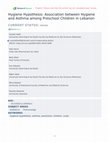
Background Our objective was the validation of a scale to assess the hygiene hypothesis and the l... more Background Our objective was the validation of a scale to assess the hygiene hypothesis and the link between hygiene, and asthma among 3 to 5 years old Lebanese children in preschool.Methods Between November 2018 and March 2019, this cross-sectional study was carried out, enrolled 515 preschool children’ asthma and potential risk factors, including hygiene, were assessed using a standardized questionnaire. A specific hygiene hypothesis related scale was generated and validated for this purpose.Results Items related to the hygiene hypothesis scale have led to a convergence over a nine factors solution, having over than 1 Eigenvalue, which explains the variance total of 65.86%. Cronbach’s alpha values corresponding to the hygiene hypothesis related scale (0.696) was deemed acceptable. The backward logistic regression, taking as dependent variable the asthma’s presence or absence in child, showed that living in prairie (ORa=2.42), playing outside (ORa=2.80), having respiratory problems...

BMC Pediatrics, 2021
Background International literature clearly describes factors associated with problematic interne... more Background International literature clearly describes factors associated with problematic internet use, including substance dependence, online gambling, social impairment, and functional difficulties. Therefore, it was imperative to assess the extent to which young adolescents in Lebanese schools are affected by problematic internet use (PIU) and the factors associated with it. This large-scale Lebanese survey aims to evaluate the relationship between PIU, depression, and substance use, including alcohol consumption and nicotine use (cigarettes and waterpipe) among adolescents in Lebanese schools. Methods This cross-sectional study conducted between January and May 2019 assessed internet use through the Internet Addiction Test (IAT), with ‘severe internet use’ being the threshold for problematic internet use. It enrolled a total of 1810 adolescents aged 14 to 17 from 16 schools from all Lebanese Mohafazat. Results The majority of the participants had an average internet use 74.8% (9...
International Journal of Adolescence and Youth, 2015

Eastern Mediterranean Health Journal, Oct 1, 2012
Waterpipe smoking and its association with chronic bronchitis has not been assessed in Lebanon. T... more Waterpipe smoking and its association with chronic bronchitis has not been assessed in Lebanon. This case-control study in Beirut in 2009/2010 evaluated this relationship: 274 cases of chronic bronchitis and 559 controls without the condition aged ≥ 40 years were enrolled. Data were collected by questionnaire on: sociodemographic characteristics, respiratory symptoms, smoking (waterpipe and cigarette) and nicotine dependence. ANOVA, Student, Kruskal-Wallis, chi-squared and Fisher exact tests were used when applicable and logistic regression analysis was carried out. Previous waterpipe smoking (OR = 6.4), previous mixed smoking (OR = 38.03) and current mixed smoking (OR = 7.68) were significantly associated with chronic bronchitis (P < 0.001 for all) but current exclusive waterpipe smoking was not (OR = 1.87, 95% CI: 0.74-4.72). Current waterpipe dependence was significantly associated with chronic bronchitis (OR = 3.74, P < 0.001). After adjustment for covariates/confounders, ever waterpipe smoking > 20 WP-years (P < 0.001) was significantly associated with chronic bronchitis.

Background: Obesity has been identified as a global epidemic and is associated with significant m... more Background: Obesity has been identified as a global epidemic and is associated with significant morbidity and mortality. Although obesity has been widely recognized for its consequences on physical health, its psychological burden in the adult populations remains unclear. Objectives: Our purpose was to address the relationship between Obesity status and psychological health within the adult young population in the Middle East and particularly in Lebanon (first aim). In addition, we intended to develop and validate a screening tool for the assessment of psychological distress (PD) in the obese young adult populations (second aim). Methods: To achieve the first aim, three studies were conducted. The first study was a systematic review and meta-analysis of observational studies that investigate the association between obesity and depression among adult populations in Middle Eastern countries. The second study was a cross sectional that aimed to explore the relationship between obesity ...
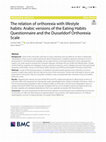
Journal of Eating Disorders, 2021
Background Some of the commonly used tools to assess orthorexia nervosa (OrNe) do not allow a mea... more Background Some of the commonly used tools to assess orthorexia nervosa (OrNe) do not allow a meaningful interpretation of the scores or yield mixed results about the dimensions needed to represent orthorexia. Since no advancement in the theoretical knowledge can be made without a thorough examination of the measurement aspects, this study aimed to evaluate the correlation between orthorexia nervosa (OrNe) and lifestyle habits, notably alcohol drinking, cigarette and waterpipe smoking, and physical exercise, and to validate and assess the psychometric properties of the Arabic versions of the Eating Habits Questionnaire (EHQ) and Düsseldorf Orthorexia Scale (DOS). Methods A total of 456 adult participants completed a self-administered questionnaire. Exploratory structural equation models were used to test the internal structure of the instruments. Shorter and more explicit versions were proposed for instruments. Pearson and partial correlations were computed between orthorexia scores...

Allergologia et Immunopathologia, 2021
Objective: The aim of this study was to elucidate the relationship between the mother’s use of ov... more Objective: The aim of this study was to elucidate the relationship between the mother’s use of over-the-counter (OTC) medications during pregnancy and asthma in Lebanese children. Methods: A cross-sectional study was conducted on Lebanese students in both public and private schools, between January and September 2017, involving 1000 children aged between 4 and 17 years. Results: The intake of any medication as an independent variable throughout pregnancy reveals that being in a public school compared to a private one (Beta = 0.344) and breastfeed-ing (Beta = 0.51) were highly associated with lower odds of asthma, while having a positive family of allergic rhinitis (Beta = 2.129) and the intake of any medication during pregnancy (Beta = 7.052) were highly associated with higher odds of asthma.A second logistic regression, taking as the dependent variable asthmatic versus healthy children and taking each OTC drug as an independent variable, showed that taking paracetamol once per week...

Introduction: Au Liban, la pharmacie clinique n’est pas appliquée professionnellement, bien qu’el... more Introduction: Au Liban, la pharmacie clinique n’est pas appliquée professionnellement, bien qu’elle soit enseignée depuis 1992 et requise par le système d’accréditation des hôpitaux établi par le Ministère de la Santé. Objectif: Évaluer l’attitude des médecins libanais sur l’intégration des pharmaciens cliniciens (PhC) dans les services de soins médicaux, et décrire leur degré d’acceptation des interventions pharmaceutiques proposées par les étudiants de 6ème année pharmacie stagiaires dans les services cliniques. Méthodes: Il s’agit d’une étude transversale, à visée descriptive, réalisée sur deux mois (Avril et Juin 2010), auprès des médecins spécialistes libanais pratiquant dans 5 hôpitaux accueillant dans leurs services des pharmaciens stagiaires provenant de différentes Facultés de Pharmacie au Liban. L’échantillon des médecins a été constitué par un sondage de grappe de premier degré. Des auto-questionnaires standardisés ont été distribués à 450 médecins. Une analyse statistiqu...

Journal of Hypertension, 2015
Objective: The present study was designed to validate the accuracy of the blood pressure (BP) mea... more Objective: The present study was designed to validate the accuracy of the blood pressure (BP) measurements of a professional device for office use, the OMRON® M3500 automatic oscillometric BP device, by using the normal and high speed modes in the adult and specific populations (obese and children), according to the ANSI/AAMI/ISO/ 81060–2:2009 Protocol. Design and method: The AAMI Protocol includes a total number of 135 subjects, 100 in the adult population (>12 years) with at least 30 % male subjects and 30 % female subjects, and an additional 35 children aged between 3 and 12 years, on which the validation is performed. For each subject, twelve sequential same-arm BP measurements using the Omron (6 for normal and 6 for high speed modes) and the mercury sphygmomanometer were performed. Results: The results showed a mean error of the individual paired determinations of the Omron and the mercury sphygmomanometers of +1.9 ± 6.35 mmHg / -3.9 ± 6.49 mmHg in the normal speed mode for ...
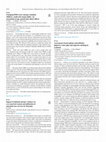
Revue d'Épidémiologie et de Santé Publique, 2018
Introduction Overweight and obesity is a critical public health issue worldwide and is associated... more Introduction Overweight and obesity is a critical public health issue worldwide and is associated with the prevalence of comorbidities such as type 2 diabetes, cancer, and cardiovascular diseases. Hierarchical age-period-cohort (HAPC) analysis is a promising methodology that has been used to examine the independent effects of age, time period, and birth cohort for the prevalence of various health outcomes. The objective of this study is to examine age, period, and cohort effects on BMI among the Canadian population, using repeated crosssectional survey data from the Canadian Community Health Survey (CCHS; 2001 to 2014). Methods Body mass index (BMI) was used to assess weight status and was calculated using self-reported height and weight values [BMI = weight (kg)/height (m 2)]. Means for BMI scores were derived to describe the time trends in weight status by age, time period, and birth cohort. Cross-classified random effects two level models were used to estimate fixed effects for age and its quadratic term at level one, and also to estimate random effects for time periods and birth cohorts at level two, while controlling for the effects of sex, model of interview, and response by proxy. Sampling weights were normalized to reflect the actual numbers of respondents participating in each cycle of the CCHS. Results The mean value for BMI, across all age groups, time periods, and birth cohorts was 24.27. The time trends in BMI appear to be very linear; at each time period, BMI increases for each successive cohort. Results of the HAPC analyses suggest that the increase in BMI in the Canadian population between 2000 and 2014 can be accounted for by age-related and secular (period) trends, as well as by cohort effects. Conclusions Overall, the results support the hypothesis that age and period effects are primarily responsible for the current obesity epidemic. It would be valuable for future research to explore changing patterns in more proximal determinants of health (e.g., health behaviours such as diet and physical activity), socioeconomic disadvantage, geographic variability, and the influence of public health initiatives, as this would provide greater understanding of the trends in overweight and obesity.
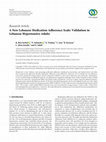
International journal of hypertension, 2018
A new Lebanese scale measuring medication adherence considered socioeconomic and cultural factors... more A new Lebanese scale measuring medication adherence considered socioeconomic and cultural factors not taken into account by the eight-item Morisky Medication Adherence Scale (MMAS-8). were to validate the new adherence scale and its prediction of hypertension control, compared to MMAS-8, and to assess adherence rates and factors. A cross-sectional study, including 405 patients, was performed in outpatient cardiology clinics of three hospitals in Beirut. Blood pressure was measured, a questionnaire filled, and sodium intake estimated by a urine test. Logistic regression defined predictors of hypertension control and adherence. 54.9% had controlled hypertension. 82.4% were adherent by the new scale, which showed good internal consistency, adequate questions (KMO coefficient = 0.743), and four factors. It predicted hypertension control (OR = 1.217; value = 0.003), unlike MMAS-8, but the scores were correlated (ICC average measure = 0.651; value < 0.001). Stress and smoking predicted...

eNeurologicalSci, 2017
Our goal is to validate and to verify the reliability of the French and English versions of the I... more Our goal is to validate and to verify the reliability of the French and English versions of the Insomnia Severity Index (ISI) in Lebanese adolescents. Study design: A cross-sectional study was implemented. Methods: 104 Lebanese students aged between 14 and 19 years participated in the study. The English version of the questionnaire was distributed to English-speaking students and the French version was administered to French-speaking students. A scale (1 to 7 with 1 = very well understood and 7 = not at all) was used to identify the level of the students' understanding of each instruction, question and answer of the ISI. The scale's structural validity was assessed. The factor structure of ISI was evaluated by principal component analysis. The internal consistency of this scale was evaluated by Cronbach's alpha. To assess test-retest reliability the intraclass correlation coefficient (ICC) was used. Results: The principal component analysis confirmed the presence of a two-component factor structure in the English version and a three-component factor structure in the French version with eigenvalues N1. The English version of the ISI had an excellent internal consistency (α = 0.90), while the French version had a good internal consistency (α = 0.70). The ICC presented an excellent agreement in the French version (ICC = 0.914, CI = 0.856-0.949) and a good agreement in the English one (ICC = 0.762, CI = 0.481-890). The Bland-Altman plots of the two versions of the ISI showed that the responses over two weeks' were comparable and very few outliers were detected. Conclusion: The results of our analyses reveal that both English and French versions of the ISI scale have good internal consistency and are reproducible and reliable. Therefore, it can be used to assess the prevalence of insomnia in Lebanese adolescents.

Journal of Asthma, 2017
Studies concerning asthma in Lebanon investigated environmental and personal factors but none of ... more Studies concerning asthma in Lebanon investigated environmental and personal factors but none of them took into account the effect of nutritional habits. Our objective is to assess the effect of nutritional habits on asthma and allergies in Lebanese children aged 3-16 years old. This is a case-control study, conducted between December 2015 and April 2016. The Food Frequency Questionnaire was composed of 16 semi-quantitative questions covering different food categories. This study included 1,276 children (976 healthy and 300 asthmatic children). Eating dairy products less than twice a week, 3-6 times per week and daily were significantly and inversely associated with asthma, as compared to never eating dairy products (p = 0.02, ORa = 0.285, CI 0.099-0.821; p &amp;amp;lt; 0.001, ORa = 0.140, CI 0.052-0.378 and p &amp;amp;lt; 0.001, ORa = 0.161, CI 0.061-0.422), whereas eating red meat daily compared to never was associated with asthma significantly (p = 0.037, ORa = 2.051, CI 1.046-4.024). Eating nuts less than twice weekly as compared to never was significantly and inversely associated with asthma (p = 0.035, ORa = 0.597, CI 0.369-0.965). The age categories 7-10 and 11-13 years were significantly associated with asthma as compared to the 3-6 years category (p &amp;amp;lt; 0.001, ORa = 3.359, CI 1.869-6.038 and p = 0.008, ORa = 2.191, CI 1.228-3.909, respectively), while male gender was significantly more prone to asthma (p = 0.014, ORa = 0.686, CI 0.507-0.926). Knowing the correlation between nutritional habits and asthma is important to promote healthy eating. Educational programs for parents about healthy food and breastfeeding encouragement is warranted.











Uploads
Papers by Pascale Salameh